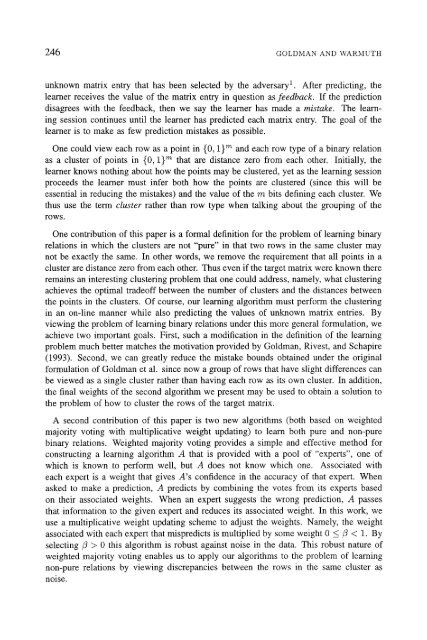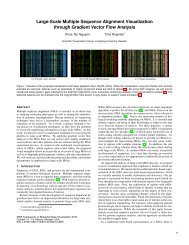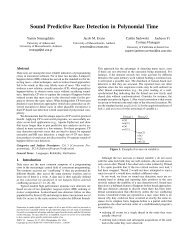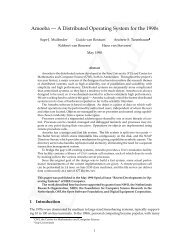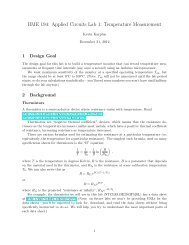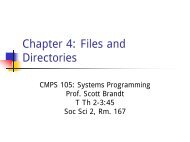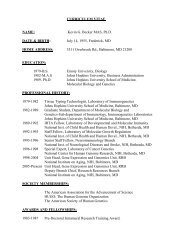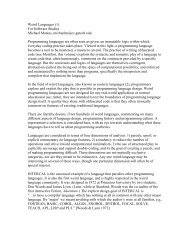Learning binary relations using weighted majority voting
Learning binary relations using weighted majority voting
Learning binary relations using weighted majority voting
You also want an ePaper? Increase the reach of your titles
YUMPU automatically turns print PDFs into web optimized ePapers that Google loves.
246 GOLDMAN AND WARMUTH<br />
unknown matrix entry that has been selected by the adversary 1. After predicting, the<br />
learner receives the value of the matrix entry in question as feedback. If the prediction<br />
disagrees with the feedback, then we say the learner has made a mistake. The learn-<br />
ing session continues until the learner has predicted each matrix entry. The goal of the<br />
learner is to make as few prediction mistakes as possible.<br />
One could view each row as a point in {0, 1} ~ and each row type of a <strong>binary</strong> relation<br />
as a cluster of points in {0, 1} m that are distance zero from each other. Initially, the<br />
learner knows nothing about how the points may be clustered, yet as the learning session<br />
proceeds the learner must infer both how the points are clustered (since this will be<br />
essential in reducing the mistakes) and the value of the m bits defining each cluster. We<br />
thus use the term cluster rather than row type when talking about the grouping of the<br />
rows.<br />
One contribution of this paper is a formal definition for the problem of learning <strong>binary</strong><br />
<strong>relations</strong> in which the clusters are not "pure" in that two rows in the same cluster may<br />
not be exactly the same. In other words, we remove the requirement that all points in a<br />
cluster are distance zero from each other. Thus even if the target matrix were known there<br />
remains an interesting clustering problem that one could address, namely, what clustering<br />
achieves the optimal tradeoff between the nnmber of clusters and the distances between<br />
the points in the clusters. Of course, our learning algorithm must perform the clustering<br />
in an on-line manner while also predicting the values of unknown matrix entries. By<br />
viewing the problem of learning <strong>binary</strong> <strong>relations</strong> under this more general formulation, we<br />
achieve two important goals. First, such a modification in the definition of the learning<br />
problem much better matches the motivation provided by Goldman, Rivest, and Schapire<br />
(1993). Second, we can greatly reduce the mistake bounds obtained under the original<br />
formulation of Goldman et al. since now a group of rows that have slight differences can<br />
be viewed as a single cluster rather than having each row as its own cluster. In addition,<br />
the final weights of the second algorithm we present may be used to obtain a solution to<br />
the problem of how to cluster the rows of the target matrix.<br />
A second contribution of this paper is two new algorithms (both based on <strong>weighted</strong><br />
<strong>majority</strong> <strong>voting</strong> with multiplicative weight updating) to learn both pure and non-pure<br />
<strong>binary</strong> <strong>relations</strong>. Weighted <strong>majority</strong> <strong>voting</strong> provides a simple and effective method for<br />
constructing a learning algorithm .A that is provided with a pool of "experts", one of<br />
which is known to perform weil, hut A does not know which one. Associated with<br />
each expert is a weight that gives ./t's confidence in the accuracy of that expert. When<br />
asked to make a prediction, A predicts by combining the votes from its experts based<br />
on their associated weights. When an expert suggests the wrong prediction, A passes<br />
that information to the given expert and reduces its associated weight. In this work, we<br />
use a multiplicative weight updating scheme to adjust the weights. Namely, the weight<br />
associated with each expert that mispredicts is multiplied by some weight 0 _ 0 this algorithm is robust against noise in the data. This robust nature of<br />
<strong>weighted</strong> <strong>majority</strong> <strong>voting</strong> enables us to apply our algorithms to the problem of learning<br />
non-pure <strong>relations</strong> by viewing discrepancies between the rows in the same cluster as<br />
noise.


